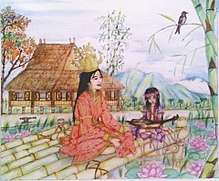List of ancient Philippine consorts
This is a list of the queen consorts of the major kingdoms and states that existed in present-day Philippines. Only the senior queens—i.e. those with the rank of Dayang and Lakambini ("Queen of the Palace")—are listed.
Rankings of consorts
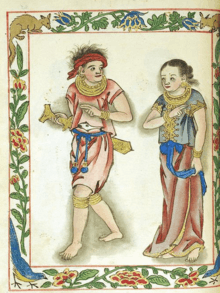
Prior to the Archaic epoch (c. 900–1565), the consorts of the Filipino monarchs were organized in three general tiers: Dayang (), Lakambini (), and Binibini (), or even the word Hara () is a Malayo-Sanskrit terms in which referred to a Queen in western sense, also meant the chief queen of the states and polities which is in the influence of India or Animist states (see also Indianized kingdoms).
The title Sultana or sultanah is an Islamic title and a feminine form of the word Sultan. This term has been legally used for some Muslim women monarchs and sultan's consorts. Nevertheless, westerners have used the title to refer to Muslim women monarchs specially in the southern part of the Philippines, which is in the Islamic influence (like Sulu and Maguindanao), sultan's women relatives who don't hold this title officially.
| Rank | Title in Baybayin / Arabic-Jawi | Description |
|---|---|---|
| Hara | (Tagalog: ) | Queen consort of a Raja |
| Dayang | (Tagalog: ) | Court lady or a female Chief spouse of Datu[1] |
| Lakambini | (Tagalog: ) | Queen of the Palace or Chief Consort of Lakan |
| Binibini | (Tagalog: ) | A Princess also a Court lady[1] |
| Dayang-dayang | (Tagalog: , Arabic: يغىل يغشىل) | A Princess also a Court lady later become Queen consort of a Sultan or a Raja in Mindanao[1] |
| Sultana | Arabic: سلطا (sulṭānah) | is an Islamic title and a feminine form of the word Sultan. This term has been legally used for some Muslim women monarchs and sultan's consorts. Nevertheless, westerners have used the title to refer to Muslim women monarchs and sultan's women relatives who don't hold this title officially. |
List of consorts
Legendary consorts
- Legendary consorts and their husbands are mentioned in the folktales and oral traditions.
- Some of the Queen consorts are claimed to be mythical, but proven to be a historic figure according in the written documents like Queen Urduja for example, she is mentioned historically as the Queen of Caboloan in Chinese accounts, but also mentioned as the Queen of the legendary kingdom of Tawalisi, found in the travel account of Ibn Battuta.[1]
| Image | Consort | Rank | Became consort | Ceased to be consort | Spouse | Notes |
|---|---|---|---|---|---|---|
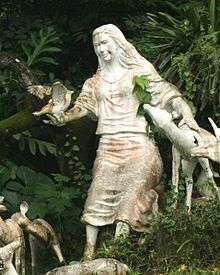 | Maria Makiling | Dayang | legendary | legendary | Captain Lara Joselito and Juan[2] | Maria Makiling is the guardian spirit of the mountain, responsible for protecting its bounty and thus, is also a benefactor for the townspeople who depend on the mountain's resources. In addition to being a guardian of the Mount Makiling, some legends also identify Laguna de Bay - and the fish caught from it - as part of her domain.[3][1] |
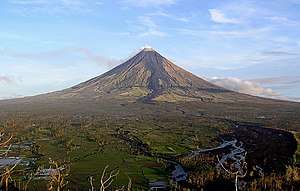 | Magayon | Princess | legendary | legendary | a Tagalog Prince Pagtuga (eruption) | (transl. Lady Beautiful) is the heroine that appears in the legend of Mt. Mayon in Albay.[4] |
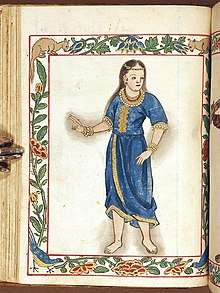 | Sasaban | Princess or Lady | c. 1300 (according to oral tradition cited by Joaquin and Vicencio)[1] Batangueño folk tradition (cited by Odal-Devora, 2000[1]), and oral tradition cited by Joaquin and Vicencio[1]) | Emperor Soledan | in oral tradition recounted by Nick Joaquin and Leonardo Vivencio, a "lady of Namayan" who went to the Madjapahit court to marry Emperor Soledan, eventually giving birth to Balagtas, who then returned to Namayan/Pasig in 1300.[1](p51) | |
| Urduja | Hara | c. 1350 | 1400 | - | a legendary warrior princess who is recognized as a heroine in Pangasinan. The name Urduja appears to be Sanskrit in origin, and a variation of the name "Udaya", meaning "arise" or "rising sun", or the name "Urja", meaning "breath". A historical reference to Urduja can be found in the travel account of Ibn Battuta (1304 – possibly 1368 or 1377 AD), a Muslim traveler from Morocco. |
Historical consorts
Caboloan (Pangasinan Wangdom)
| Image | Consort | Rank | Became consort | Ceased to be consort | Spouse | Notes |
|---|---|---|---|---|---|---|
| Urduja | Hara | c. 1350 | 1400 | - | The Queen regnant of Caboloan, but presumed to be legendary.[5] |
Tondo Dynasty
Tondo have a personal union with Namayan through the traditional lineage of Kalangitan and Bagtas.[1]
| Image | Consort | Rank | Became consort | Ceased to be consort | Spouse | Notes |
|---|---|---|---|---|---|---|
| Angkatan | Dayang | c. 900 | ? | Namwaran | Known in LCI.[6][7] | |
| Buka | Dayang | c. 900 | ? | Jayadewa | Known in LCI. She was married to Senapati Jayadewa, as a bargain to clear the debt of 1 kati and 8 suwarnas of her parents Namwaran and Dayang Angkatan.[8][6][7] | |
| Panginoan | Dayang | c. 1300[1] (Oral tradition) | Gat Balagtas of Sapa and Taal, Batangas[1] | In oral tradition recounted by Nick Joaquin and Leonardo Vivencio, "Princess Panginoan of Pasig" who was married by Balagtas, the son of Emperor Soledan of Majapahit in 1300 AD in an effort consolidate rule of Namayan.[1](pp47,51) | ||
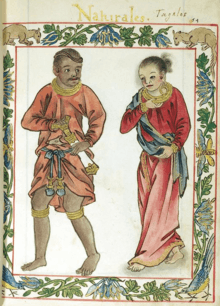 | Kalangitan | Dayang[9] | c. 1450 | 1515 | Rajah Lontok | The only Queen regnant in the history of Kingdom of Tondo.[9] |
 | Malyag | Dayang | - | Mother of Rajah Lontok of Namayan. | ||
 | Lahat | Dayang | Gat Timog | |||
Namayan
Namayan have a personal union with Tondo through the traditional lineage of Kalangitan and Bagtas. (Legendary antiquity)[1]
| Image | Consort | Rank | Became consort | Ceased to be consort | Spouse | Notes |
|---|---|---|---|---|---|---|
 | Sasaban | Princess or Lady | prior to 1300 (according to oral tradition cited by Joaquin and Vicencio)[1] | ? | Emperor Soledan | Batangueño folk tradition (cited by Odal-Devora, 2000),[1] and oral tradition cited by Joaquin and Vicencio.[1] |
| Panginoan | Dayang | c. 1300 according to oral tradition cited by Joaquin and Vicencio[1] | ? | Gat Balagtas of Sapa | In oral tradition recounted by Nick Joaquin and Leonardo Vivencio, "Princess Panginoan of Pasig" who was married by Balagtas, the son of Emperor Soledan of Madjapahit in 1300 in an effort consolidate rule of Namayan.[1](pp47,51) | |
Maynila
According to Bruneian oral tradition,[10] a city with the Malay name of Selurong, which would later become the city of Maynila) was formed around the year 1500. According to some of these oral traditions, the Sultanate of Brunei under Sultan Bolkiah attacked the Kingdom of Tondo, and established Selurong.[11]
| Image | Consort | Rank | Became consort | Ceased to be consort | Spouse | Notes |
|---|---|---|---|---|---|---|
| Unknown[12] | Hara | c.1400's or 1500 | 1521 | Firsthand accounts generally accepted by Philippine historiographers, although with corrections for hispanocentric bias subject to scholarly peer review.[13] The veracity of "quasi-historical" (meaning not physically original) genealogical documents also remains subject to scholarly peer review.[12] She served as Paramount ruler of Manila after the death of her husband. Her period of reign covered the youth of Rajah Matanda,[2] including the time Ache spent as commander of the Bruneian navy.[14] | ||
 | Lela Mecana also known as Chanai Lela[15] | Sultana | 1485 (husband's reign) | 1524 (husband's reign) | Bolkiah | She is a princess of Sulu who is the spouse of Bolkiah who invaded and conquered Selurong in the 15th century,[16] her husband was also the Sultan of Bruneian Empire.[15] |
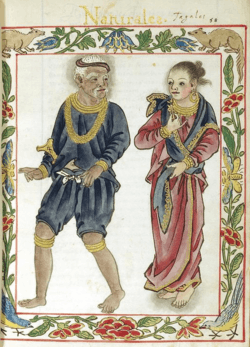 | Ismelia or Ysmeria | Dayang Sultana | 1515 (husband's reign) | 1558 (husband's reign) | Rajah Sulaiman I |
Rajahnate of Cebu
| Image | Consort | Rank | Became consort | Ceased to be consort | Spouse | Notes |
|---|---|---|---|---|---|---|
| Humamay or Humamai | Hara | Before 1521 (husband's reign) | ? (husband's reign) | Rajah Humabon | Later changed its name to Juana after she converted to Roman Catholic.[17] |
Kedatuan of Dapitan
| Image | Consort | Rank | Became consort | Ceased to be consort | Spouse | Notes |
|---|---|---|---|---|---|---|
| Bugbung Humasanum | Dayang (Princess) | c. 12th century[18] | unknown (husband's reign) | Datu Sumanga | Datu Sumanga raids China to win the hand of Dayang-dayang Bugbung Humasanum.[18] |
Sultanate of Maguindanao
| Image | Consort | Rank | Became consort | Ceased to be consort | Spouse | Notes |
|---|---|---|---|---|---|---|
 | Three (3) named consorts: Angintabo Simbaan Masawang | Dayang-dayang | 1520 (husband's reign) | 1543 (husband's reign) | Sharif Kabungsuwan | a daughter of Macaapun Rajah, A princess from Malabang and Angintabo's niece.[19] |
| Unknown Princess | Dayang-dayang | ? (husband's reign) | ? | Sharif Kabungsuwan | a daughter of Macaapun Rajah. | |
 | Daragat | Dayang | ? | daughter of Sharif Kabungsuwan.[19] | ||
Sultanate of Sulu
| Image | Consort | Rank | Became consort | Ceased to be consort | Spouse | Notes |
|---|---|---|---|---|---|---|
| Paramisuli | Dayang-dayang | c. 17 November 1405 | ? | Sharif ul-Hāshim of Sulu | [5] | |
| Tuambaloka | Dayang-dayang | 1649 | 1650 | Rajah Bongso | A woman from Basilan who ascended to power and become the Queen consort of Jolo known for her bravery as she and her husband held of the invaders with 4,000 warriors.[5] | |
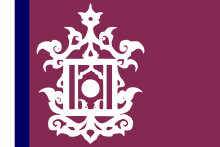 | Piandao Kiram | Hadji Dayang-dayang | Muedzul Lail Tan Kiram | [5] | ||
 | Tarhata Kiram | Hadji Dayang-dayang | [5] | |||
| Emraida Kiram | Hadji Dayang-dayang | 1967 Miss World[5] |
See also
- First Lady or First Gentleman of the Philippines
- Binukot - Filipino cultural practice that secludes a young person (usually a young woman)
- History of the Philippines (900–1521)
- List of sovereign state leaders in the Philippines
- List of recorded Datus in the Philippines
- Filipino styles and honorifics
- Greater India
References
- Odal-Devora, Grace (2000). Alejandro, Reynaldo Gamboa; Yuson, Alfred A. (eds.). The River Dwellers. Pasig : The River of Life. Unilever Philippines. pp. 43–66.
- Lanuza, Michelle, The Legend of Maria Makiling, archived from the original on 2007-10-02, retrieved 2007-09-30
- http://www.kuro5hin.org/story/2003/6/20/21542/7380
- https://www.webcitation.org/query?url=http://www.geocities.com/yosemite/3712/tmagayon.html&date=2009-10-26+03:12:49
- http://www.filipiknow.net/filipina-muslims-philippine-history/
- (2010-05-07). "Laguna Copperplate Inscription". All Philippines. Retrieved on 2011-11-17.
- Tiongson, Jaime F. (2010-08-08). "Laguna Copperplate Inscription: A New Interpretation Using Early Tagalog Dictionaries" Archived 2012-09-29 at the Wayback Machine. Bayang Pinagpala. Retrieved on 2011-11-18.
- "Archived copy" (PDF). Archived from the original (PDF) on 2017-08-22. Retrieved 2017-06-29.CS1 maint: archived copy as title (link)
- "Timeline / Pre-Colonial". City of Pasig. Archived from the original on 7 July 2017. Retrieved 8 May 2017.
- Scott, William Henry (1994). Barangay: Sixteenth Century Philippine Culture and Society. Quezon City: Ateneo de Manila University Press. ISBN 971-550-135-4.
- del Mundo, Clodualdo (September 20, 1999). "Ako'y Si Ragam (I am Ragam)". Diwang Kayumanggi. Archived from the original on 25 October 2009. Retrieved 2008-09-30.
- Aganduru Moriz, Rodrigo (1882). Historia general de las Islas Occidentales a la Asia adyacentes, llamadas Filipinas. Colección de Documentos inéditos para la historia de España, v.78–79. Madrid: Impr. de Miguel Ginesta.
- Junker, Laura Lee (1998). "Integrating History and Archaeology in the Study of Contact Period Philippine Chiefdoms". International Journal of Historical Archaeology
- de Aganduru Moriz, Rodrigo (1882). Historia general de las Islas Occidentales a la Asia adyacentes, llamadas Filipinas. Colección de Documentos inéditos para la historia de España, v.78–79. Madrid: Impr. de Miguel Ginesta.
- "Archived copy". Archived from the original on 2015-10-03. Retrieved 2015-10-02.CS1 maint: archived copy as title (link)
- http://www.manilatimes.net/the-filipina-as-ritualist-and-warrior/81079/
- "Archived copy". Archived from the original on 2007-10-31. Retrieved 2007-09-28.CS1 maint: archived copy as title (link)
- http://www.discoverbohol.com/Features/Dauis-History-Part-1.htm
- Halili, M. (2004). Philippine History. Rex Book Store. p. 52. ISBN 9789712339349. Retrieved 2015-08-23.

.svg.png)

